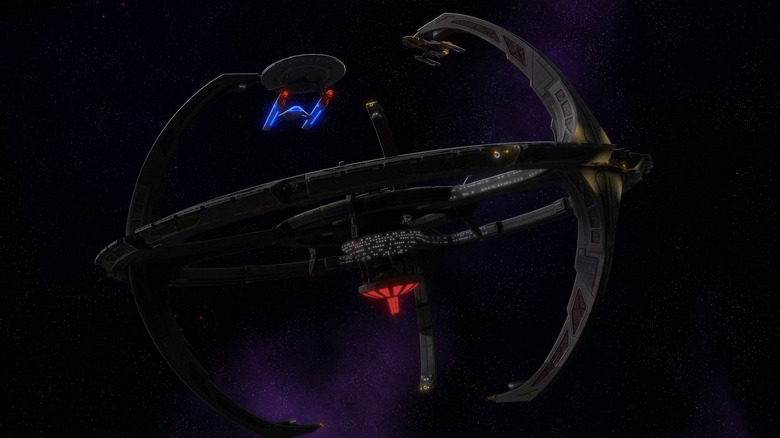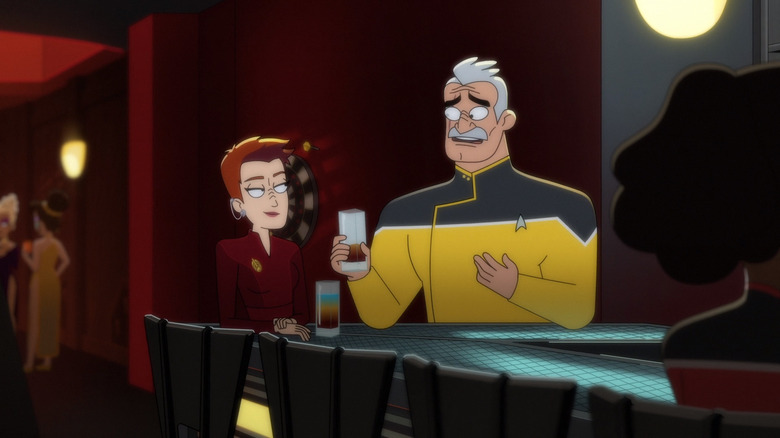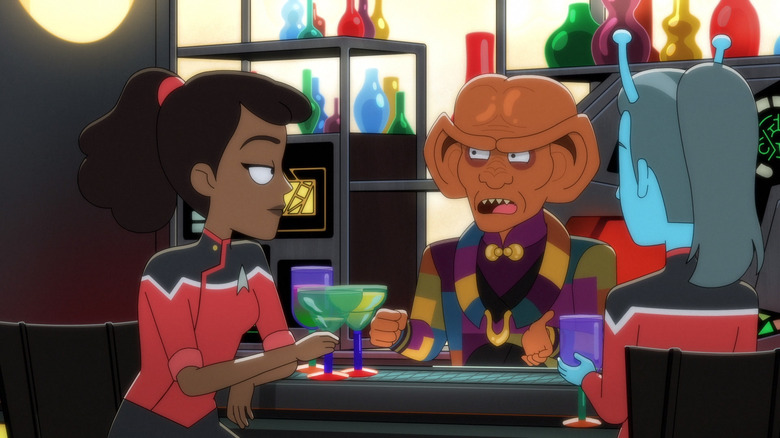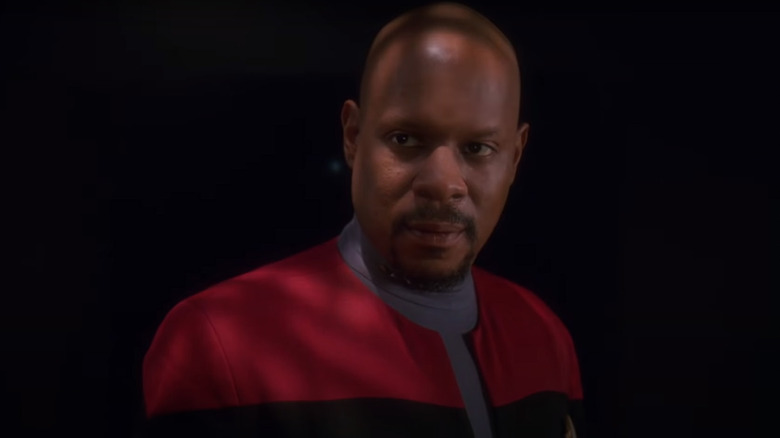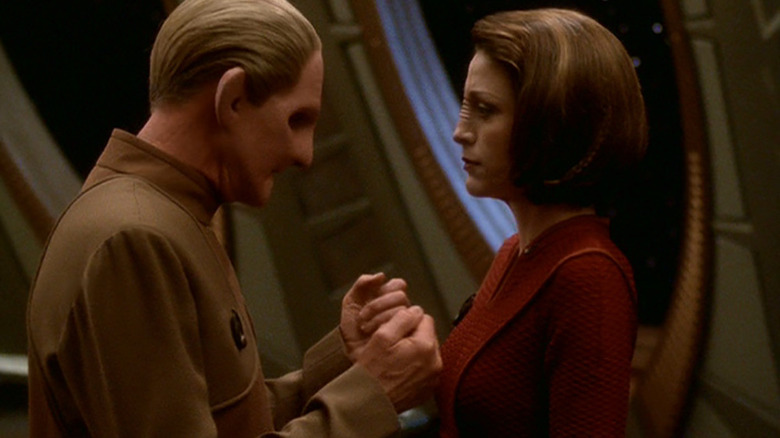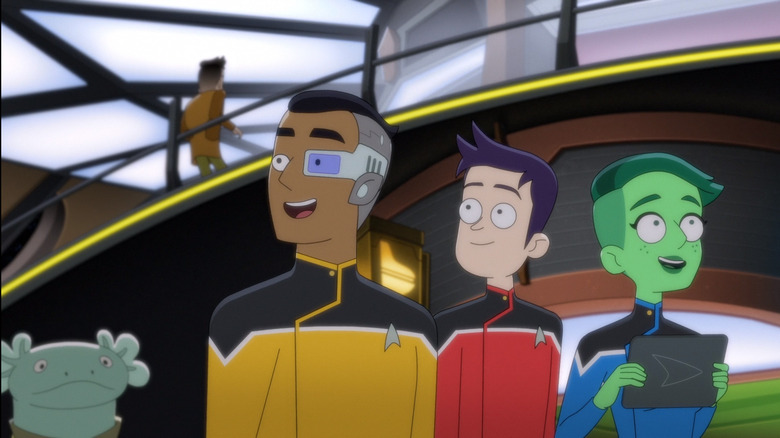The Deep Space Nine Episode Of Star Trek: Lower Decks Is A Love Letter To Trek's Finest Series
"Star Trek: Lower Decks" injects its irreverent comedy with a lot of love for the "Star Trek" franchise, and it's truly a series made by fans, for fans. The lower deckers of the California-class U.S.S. Cerritos are, like us, huge fans of the exploits of the Enterprise, and frequently reference characters and events from the original series and "Star Trek: The Next Generation." Will Riker (Jonathan Frakes) and Deanna Troi (Martina Sirtis) even made cameos, delighting fans of "Next Generation" to no end and making the animated workplace comedy feel even more cemented in the canon of the "Star Trek" universe. For fans of "Star Trek: Deep Space Nine," however, there have only been a handful of fun Easter eggs and one-off deep cut jokes to whet fan appetites. Now, in season 3, the crew of the Cerritos have actually set foot on the promenade and had a drink at Quark's, which feels like pure television magic.
"Star Trek: Deep Space Nine" had a rough start, with fans of the franchise uncertain about a series where the main focus wasn't exploring the universe, but has grown to be a favorite among Treikkies with a truly devoted fanbase. The latest "Lower Decks" episode, "Hear All, Trust Nothing," gives "Deep Space Nine" the love and reverence it deserves, and hopefully might inspire some fans who like other "Trek" shows to give the space station series a shot. After all, it's the best "Star Trek" in existence.
A nostalgia trip down the promenade
I have waxed poetic about my love for "Star Trek: Deep Space Nine" in the past, but it's hard to explain the warm, fuzzy feeling I got watching the Deep Space Nine episode of "Lower Decks." Returning to the promenade and seeing and hearing Quark (Armin Shimerman) and Kira (Nana Visitor) again was like a reunion with old friends, and the "Lower Decks" team made sure to include plenty of little details for the die-hard Deep Space Niners. (Is that what we're called? That's what I'm calling us.) There are some more obvious bits, like Morn sitting in his usual spot, games of dabo, and Rutherford (Eugene Cordero) wanting to re-enact moments from Jake Sisko's (Cirroc Lofton) life, but there are some more sly nostalgic dopamine hits, like the dart board that Miles and Bashir used to play at, or Quark's trademark high-pitched wails of fear. Seriously, a Quark scream is only one step down from a Wilhelm scream when it comes to being recognizable.
Like its franchise siblings, "Star Trek: Deep Space Nine" used its science fiction setting to deal with real world issues through allegory, but it was the first "Star Trek" series to be almost completely character-driven, with its stationary location forcing characters into unique situations and even more unusual relationships. It's the most morally ambiguous and creatively complex "Star Trek" series, which may be too much for fans who like the cut-and-dry Gene Roddenberry idealism of the other shows. For me, however, these incredibly relatable and flawed characters were what made "Star Trek: Deep Space Nine" worth celebrating, and it's clear that the team behind "Lower Decks" feel the same way.
A space for every species
Everything about Deep Space Nine is a little unusual. It's a former Cardassian base next to the planet Bajor, which was only recently liberated from Cardassian rule. Now it's run by Starfleet, in conjunction with the new Bajoran government, and they're trying to help the planet heal while also dealing with a wacky wormhole that provides an express trip across the galaxy. The Bajorans also worship the wormhole as the temple of their gods, the Prophets. Everyone was slightly off their game, whether it was the Starfleet officers trying to handle unknown territory, the Bajorans trying to make sense of a post-occupation world, and even the people who made the station their home purely by choice, like the Ferengi businessman Quark. Everything felt uncharted despite the characters staying physically still, and it provided ample opportunity to fully flesh out characters that normally wouldn't get an episode's time in other "Trek" shows.
"Star Trek: Deep Space Nine" not only introduced us to the incredible culture of the Bajorans and the intricate impacts of the Cardassian war, but it also gave new depth to the Ferengi and the Klingons, who had previously been somewhat one-note. While Michael Dorn's Worf originated on "Star Trek: The Next Generation," it was his time on "Deep Space Nine" that allowed the character to grow and flourish, and introduced some of the best Klingon characters in "Trek" history, like General Martok. Instead of only offering the somewhat-homogenous Starfleet perspective, "Deep Space Nine" showed fans some outside points of view, and gave some of its alien characters a chance to really shine.
A Star Trek that embraces nuance
Speaking of aliens, one of the series' most compelling characters is a Cardassian tailor-slash-spy named Garak (Andrew Robinson), and he's as close to an antihero as any character in "Star Trek" has ever come. He highlights the fact that "Deep Space Nine" is interested in the gray areas of life, something that Starfleet is often hesitant to even discuss. War forces people to make difficult decisions, and it also changes those people. Over the course of seven seasons, the characters on the series all grow and change, some in very surprising ways. While some Trekkies claim that Captain Sisko (Avery Brooks) is a poor captain because of his hot temper, I would argue that he's the best "Trek" captain of all, because his passion is for doing what's right and protecting his crew. He's the freaking Emissary of the Prophets for a reason, even if he's not as tactically brilliant as Picard or as charismatic as Kirk. Sisko is as complex as the rest of the crew of Deep Space Nine, as he's a spiritual man chosen by a foreign faith who is also a military leader, a single father, and a big nerd who loves cooking and baseball. Sometimes he makes the wrong decision, but as an audience, we often understand why.
Everyone on "Deep Space Nine" has skeletons in their closet, but the show helps them unpack those issues and become better people. Almost every series these days deals with trauma and its effects on people, but "Deep Space Nine" was delving deep into the topic all the way back in 1997. "Deep Space Nine" didn't see its characters as just ideas on a page, but as people.
A cast that cared about their characters
That level of empathy extends not only to the protagonists of "Deep Space Nine," but also its villains, who are all brilliantly realized and multi-faceted. Cardassian leader Gul Dukat (Marc Alaimo) is compelling because he truly believes he's doing the right thing, and has completely deluded himself into believing his actions are just. Kai Winn (Louise Fletcher) is the yin to his yang, taking over Bajor's religious leadership and believing herself to be chosen for greatness. Both are despicable, but each is given pathos normally reserved for heroes. The actors on "Deep Space Nine" were encouraged to really dig into their characters and add more to their stories, and having that kind of passion behind the performances allowed for even the most arch of villains to occasionally be somewhat relatable. Also, they had Jeffrey Combs play not just one but two very different villains, which is genius and should be done more often.
If you watch the "Deep Space Nine" documentary, "What We Left Behind," the attachment these actors had to their characters is palpable. They injected themselves into their art, and created deep, long-lasting bonds with their cast mates that translate to incredible onscreen camaraderie. In my interview with Nana Visitor, she said that playing Kira changed her as a person, which in turn inspired viewers out there like me:
"You dropped thoughts in your head, and it actually changes the way your brain synaptically forms. So I was shifted by this character in really good ways, in having to accept foibles and having to self-examine. She did a lot of good for me. So it's joyful for me to step into who she is."
On "DS9," anyone could be a hero, regardless of their past.
Trying new things with Trek
Both "Lower Decks" and "Deep Space Nine" tried to do something different with the "Star Trek" formula, to fantastic and franchise-changing results. "Lower Decks" is "Star Trek" as an animated workplace comedy, but "Deep Space Nine" was often "Star Trek" as a wartime drama, where the office is the front lines. It's like "M*A*S*H" with replicators and phasers, but the anti-war sentiment and military hijinks are surprisingly similar. Both focus heavily on character development and interpersonal relationships between the people on a starship, and both play with both the miraculous and the mundane (like replicator nachos) in equal measure. Some of the other "Star Trek" shows might be focused on grand overarching journeys, big bold ideas, and characters as archetypes, but "Lower Decks" and "Deep Space Nine" are both so ... human.
The entirety of "Star Trek: Deep Space Nine" is available to stream on Paramount+, and new episodes of "Star Trek: Lower Decks" premiere Thursdays, also on Paramount+.
